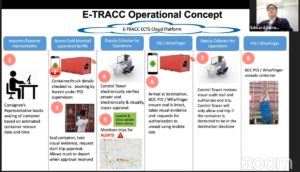

The Bureau of Customs (BOC) eyes adoption of its Electronic Tracking of Containerized Cargo (E-TRACC) System in July or August at the ports of Bataan, Cebu, Clark, Subic and Davao, according to Assessment and Operations Coordinating Group deputy commissioner Atty. James Edward Dy Buco.
The system will also be implemented in phases at Philippine Economic Zone Authority (PEZA) locations, Dy Buco said at the third Supply Chain Analytics Networks Hub E-Forum on July 2.
E-TRACC, which was launched on May 1, is a Web-based system that allows BOC to track, monitor, and audit the location and condition of cargoes, as well as obtain real-time alarms on, among others, diversion and tampering of cargoes.
READ: BOC orders e-tracking of cargoes in transit
Dy Buco said E-TRACC is already being pilot tested at the Manila International Container Port (MICP), Port of Manila and Port of Batangas for customs bonded warehouses (CBW) and cold storage facilities.
READ: BOC-MICP starts implementing container cargo e-tracking from June 18
Dy Buco said BOC on July 6 will start training personnel in Subic, Clark and Bataan. Since Cebu is under enhanced community quarantine until July 15, BOC will conduct training there online.
For imports bound for PEZA zones, Dy Buco said E-TRACC implementation may be “fully implemented in the month of July.”
He noted, however, that BOC will still be coordinating with PEZA to identify which industries will be first covered by the system.
Dy Buco pointed out that E-TRACC, pursuant to Customs Memorandum Order (CMO) No. 04-2020, applies to both import and export containerized cargoes. It does not cover air shipments as these do not come in containers.
CMO 04-2020, issued last February, implements Customs Administrative Order No. 15-2019, which covers movement within customs territory of foreign goods for outright exportation, warehousing, and those admitted to Free Zones, as well as the transfer of goods from customs facilities and warehouses (CFW).
All container vans covered by CMO 04-2020 will be affixed with an electronic customs seal (ECS) before being cleared to depart from the starting point or point of discharge for the voyage to the end point or point of destination.
The ECS is a GPS-enabled sealing device or lock that can physically secure a cargo and provide real-time information on its location.
Except when circumstances warrant under CMO 04-2020, full completion of customs cargo clearance is mandatory before any shipment is sealed with an ECS.
Subject containers are:
- Import containers bound to container yard/container freight station (CY/CFS) or other CFWs; transit of cargo bound for Free Zones, inland customs office, depots, or terminals; transit to CBWs.
- Export containers from Free zones, inland customs office, depots or terminals, and CBWs to port of loading.
- And transfer of shipments subject to further verification and/or monitoring.
For exports, Dy Buco said the system covers not only PEZA zones, but all other Free zones under the jurisdiction of Freeport authorities.
For imports, E-TRACC applies to all containers, duties and taxes of which have not yet been paid. However, certain products for consumption, duties and taxes have been paid prior to release, are also covered, such as reefer cargoes.
Asked if there can be a priority lane for reefer containers, Dy Buco said reefer cargoes are already given priority due to the nature of the shipment.
BOC will have an E-TRACC System dashboard showing the data collected and transmitted by the system service provider.
This will allow BOC to monitor movement and location of all containers as well as get real-time alarms both on the dashboard and by email.
Importers will be able to monitor movement of their containers through the system and can also authorize their customs brokers to have access to the system.
Booking for the E-TRACC trip can be made a day before or up to one hour before departure of the container.
Asked how BOC will prevent Customs personnel from intentionally delaying the tagging of ECS in containers, Dy Buco said one of BOC’s priority programs is to install CCTV cameras in all areas of operations.
Under CMO 04-2020, BOC’s Piers and Inspection Division, or its equivalent office at each port of entry or destination, will remotely monitor the sealing and unsealing operations, authorize the start and end trip of the vehicle loaded with transit import/export cargo, and monitor for alarms.
Opening by any customs officer of transfer/transit import cargo that does not have the required ECS will not be allowed without approval of the district collector at the port of delivery in coordination with the district collector at the port where the container was approved for transfer/transit.
BOC’s Enforcement and Security Service will be notified immediately to make an investigation and submit findings to the Customs commissioner and district collector.
Dy Buco assured stakeholders BOC has adequate manpower to implement the E-TRACC System 24/7, with personnel to be deployed in shifts.
On the question of whether E-TRACC is a duplication of PEZA’s requirement for a seal, Dy Buco said this will be part of BOC’s discussion with PEZA. He noted the BOC “cannot do away” with the E-TRACC System as it will also be interfaced with BOC’s other automation projects, such as the inventory management system for CBWs.
E-TRACC requires the payment of P500 per ECS within a 10-kilometer radius from port of discharge and P700 beyond the 10-km radius from port of discharge.
The charge covers both the “arming” and “disarming” of the ECS.
Dy Buco said the fee replaces other expenses, such as boat notes, underguarding, and payment for overtime. – Roumina Pablo




